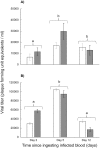Transmission risk of two chikungunya lineages by invasive mosquito vectors from Florida and the Dominican Republic
- PMID: 28749964
- PMCID: PMC5531436
- DOI: 10.1371/journal.pntd.0005724
Transmission risk of two chikungunya lineages by invasive mosquito vectors from Florida and the Dominican Republic
Abstract
Between 2014 and 2016 more than 3,800 imported human cases of chikungunya fever in Florida highlight the high risk for local transmission. To examine the potential for sustained local transmission of chikungunya virus (CHIKV) in Florida we tested whether local populations of Aedes aegypti and Aedes albopictus show differences in susceptibility to infection and transmission to two emergent lineages of CHIKV, Indian Ocean (IOC) and Asian genotypes (AC) in laboratory experiments. All examined populations of Ae. aegypti and Ae. albopictus mosquitoes displayed susceptibility to infection, rapid viral dissemination into the hemocoel, and transmission for both emergent lineages of CHIKV. Aedes albopictus had higher disseminated infection and transmission of IOC sooner after ingesting CHIKV infected blood than Ae. aegypti. Aedes aegypti had higher disseminated infection and transmission later during infection with AC than Ae. albopictus. Viral dissemination and transmission of AC declined during the extrinsic incubation period, suggesting that transmission risk declines with length of infection. Interestingly, the reduction in transmission of AC was less in Ae. aegypti than Ae. albopictus, suggesting that older Ae. aegypti females are relatively more competent vectors than similar aged Ae. albopictus females. Aedes aegypti originating from the Dominican Republic had viral dissemination and transmission rates for IOC and AC strains that were lower than for Florida vectors. We identified small-scale geographic variation in vector competence among Ae. aegypti and Ae. albopictus that may contribute to regional differences in risk of CHIKV transmission in Florida.
Conflict of interest statement
The authors have declared that no competing interests exist.
Figures








References
-
- Kumar CVMN, Gopal DVRS. Reemergence of Chikungunya virus in Indian subcontinent. Indian J Virol. 2010;21: 8–17. doi: 10.1007/s13337-010-0012-1 - DOI - PMC - PubMed
-
- Chretien JP, Anyamba A, Bedno SA, Breiman RF, Sang R, Sergon K, et al. Drought-associated chikungunya emergence along coastal East Africa. Am J Trop Med Hyg. 2007;76: 405–407. - PubMed
-
- Leparc-Goffart I, Nougairede A, Cassadou S, Prat C, de Lamballerie X. Chikungunya in the Americas. Lancet. 2014;383: 514 doi: 10.1016/S0140-6736(14)60185-9 - DOI - PubMed
-
- Lanciotti RS, Valadere AM. Transcontinental movement of Asian genotype chikungunya virus. Emerg Infect Dis. 2014;20(8): 1400–1402. doi: 10.3201/eid2008.140268 - DOI - PMC - PubMed
MeSH terms
LinkOut - more resources
Full Text Sources
Other Literature Sources
Medical

